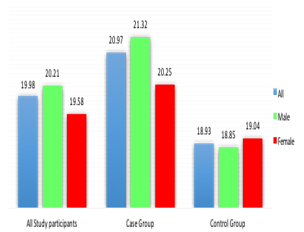Abstract
Post-traumatic headache (PTH) is defined by the International Headache Society as a headache developing within seven days of the injury or after regaining consciousness. PTH is commonly associated with memory and concentration problems, sensitivity to loud sounds or bright lights, fatigue and many symptoms including insomnia, dizziness, poor and personality changes like depression and nervousness. The total number of participants in this study is one hundred and three, fifty-three of them (36 males and 17 females) are in the case group while the other fifty (29 males and 21 females) are in the control group. All of them aged between 20-40 years. Only 25 patients had headache in ER, while 29 of them visited the out patient’s clinic suffering from post traumatic headache in the next two months. The mean of S100B and that of NSE in case group are higher than that in control group. Regarding the gender, the mean of S100B is higher in males of case group than that in control group, while the mean of NSE in males and females in case group is higher than that in control group. The means of S100B and NSE in patients who had a headache in ER are higher than that in patients with no headache. The means of S-100 B and NSE in patients complaining of a post-traumatic headache who had a headache in ER are higher than that in patients also complaining from a posttraumatic headache but had no headache in ER. S-100 B and NSE are useful biochemical markers for brain injury in mild traumatic brain injury (MTBI) patients and seem to be associated with the presence of a headache in ER after trauma. These biochemical markers with a headache in ER can predict a post-traumatic headache in the near future.
Full text article
Authors

This work is licensed under a Creative Commons Attribution-NonCommercial-NoDerivatives 4.0 International License.

